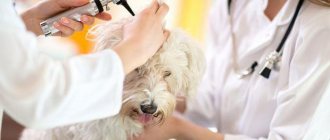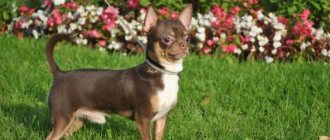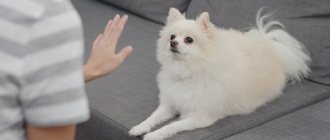During the period when he begins to actively grow and his teeth change, changes occur in his ear cartilage: it “breaks”. This process can take a long time, and there are times when the cartilage never comes into place. Therefore, the dog owner has questions: what to do about it, why glue the ears and how to glue them? Let's try to answer them together.
Pugs have three types of ear shapes:
- “button” - the ear has a triangular shape, hangs on the cartilage and closes the ear canal;
- “rose” - the ear is broken in the cartilage and the ear canal is slightly open;
- “false rose” - the ear, broken in the cartilage, sits high and almost completely opens the ear canal.
The most preferred ear shape is the “button” shape. “Rose” is also allowed by the standard, but “false rose” and different ears are completely undesirable for pugs. Therefore, the shape of pug ears is adjusted so as to give them the same position and “button” appearance. In addition to the cosmetic disadvantage, the “rose” shape, and especially the “false rose,” poorly protects the pug’s ear from dirt, water and strong wind. This can even lead to the dog getting sick.
How to glue pug ears correctly?
Most often, this procedure does not cause any inconvenience to puppies. However, you should keep an eye on his ears to ensure there is no irritation or redness from the patch. If this happens, the patch should be removed and the ear should be allowed to rest for a while, and then the procedure should be repeated.
The pug's ears need to be glued in this way for one and a half to two weeks, or until the patch falls off on its own. As long as the ears maintain the correct shape, a patch is not needed, but as soon as the puppy’s ear “breaks,” adjustments are needed again. Usually, after reaching the age of one year, the pug’s ears acquire the correct shape, but sometimes it happens that the patch needs to be glued until the age of two.
Chinese Cresteds have rather weak ear cartilage and in order to help their ears stand up, they need to be glued from a very early age. There are many different ways, but in this article we will look at three main ones.
In order to glue the puppy's ears, we will need: scissors, adhesive tape and cotton swabs.
First, we clean our ears with a special product and disinfect them with gasoline. It is very important that the ear is dry after this! Under no circumstances should you wrap your ear if there is any liquid left inside!!!
For all three methods, the same workpiece is useful.
We take a cotton swab, remove the cotton wool from both ends, and cut the tube in half.
Cut four identical strips of adhesive tape. The length of each strip should be slightly less than the length of the puppy's ear. The width is correspondingly also slightly less than the width of the ear.
Take half the stick and glue it exactly to the middle along the width of the cut strip. Pay attention to the position of the stick - one end of it should be at the very edge of the strip of plaster, and the other should not reach the other edge. After that, stick another strip of plaster on top, sticky side up. The result is that a plastic stick is glued between two layers of adhesive tape.
We get an elongated strip with the sticky side at the top. We take scissors and round off the side of the strip where the length of the stick was not enough.
Using the same principle, we make a blank for the second ear. The base blank for both ears is ready!
Let's start gluing.
Method No. 1
This method is used to help the ears when they are almost standing up.
All the hair on the inside and outside of the ears is cut off. This way we lighten the ears and make them thinner.
To properly stick the base inside the ear, you need to grab the tip of the ear and gently pull up to smooth out the crease. The main thing is not to overdo it! Under no circumstances should you pull your ear too hard!
We take the blank and paste it on the inside of the ear, starting just below the place that we “smoothed”. Glue with the rounded end up. Carefully glue and press lightly so that the patch sticks to the ear better.
Puppy with baby elephant ears Dumbo is ready :)
Method No. 2
You can glue ears in this way from the age of 3 weeks.
It is better to trim the ears on the outside so that later you can remove the adhesive plaster more painlessly.
Cut a strip of plaster long enough to wrap around your ear. For Chinese abalone, a strip of 7-9 cm is enough.
Inside the ear we glue the base blank as in method No. 1. Fold the ear in half.
We begin to wrap the ear with adhesive tape. The main thing is not to pinch your ear—you don’t need to pull the patch too hard. The ear turns out to be twisted in the form of a tube.
The puppy with alien horns is ready :)
How to glue a dog's ears. Gevelinka 11.05.13, 06:42
Some dogs have weak ear cartilage and need to be glued to help the ear stand up. There are several different ways to do this. You need to start gluing up the ears the sooner the better, until they are fully and confidently “standing”. Try starting bonding at 3 weeks of age.Depending on the density of the ear tissue and the strength of the cartilage, the ears can either stand up on their own very early, or they can only get stronger by the age of one year, or they may not stand up at all, alas.
Simultaneously with gluing, the puppy can be given Stride+, GAG, and Gelakan supplements. Edible gelatin and ear massage also help a lot. Pour half a teaspoon of gelatin with cool water, let it swell and feed it to the dog with any wet food.
Method 1.
The main “mechanism” is cut out of a plastic bottle. The main thing is that this bottle is not round, but has an oval cross-section and fits the size of your dog’s head (the distance between the ears).
Method 2.
You will need a roll of cotton-based adhesive plaster and ear cleaning sticks. The patch is cut into squares, approximately 10x10 mm.
First, thoroughly clean and degrease the ear (with gasoline). We stick the patch on the inside of the ear, starting from the cartilage in the auricle. We press each square carefully! Using pieces of plaster we glue a “path” to the top, with a large overlap: the upper square overlaps the lower one by 70%, pressing each square tightly.
After the “track” is glued, take a stick to clean your ears. We place the stick on the glued “track” and, using the same pieces of plaster, begin to glue it over the “track”. Pressing carefully, with a large overlap, we glue the entire stick to the top.
After the frame is ready, cut the plaster strip approximately 12 mm wide. Glue the end of the tape to the outside of the ear at the base of the skull. We begin to wrap the ear around, towards the neck. Important! Not tightly, so as not to pinch the ear, start winding upward, forming a cone. Do not try to use a long strip of plaster; it is better to do it in short strips (30 cm).
After we have formed a cone, carefully powder the bottom of the ear, near the patch, with baby powder. Try powdering the inside of the ear and first, under the cone. A correctly formed cone, loose enough, does not tighten the ear, and the little finger fits under the cone.
Then, lifting the ear in the same direction, we re-glue the cone, forming a cone as close to the skull as possible, on top of the powdered area of the ear. The cone is glued with the overlap of the patch; it is a frame that holds the ear vertically.
We also glue the second ear. The next step is to fix both cones with a figure of eight made of adhesive tape, approximately 10 mm wide.
Then we fix the figure eight on each cone so that it does not move. We also fix the figure eight in the center, fastening it with a short strip of plaster.
In this condition, the ears can be glued for 10-15 days. In order to avoid irritation regularly - every day, you should powder your ears with powder at the base of the bandage winding, try to get the powder under the base of the cone.
Observe the puppy and its behavior carefully. If he pays attention to his ears, tries to scratch them, if redness or inflammation appears on the skin, then he should immediately remove the wrapping and treat the ears.
We treat the ears with a 70% alcohol solution. If there is irritation or scratching on the skin, they should be treated with an antiseptic and sprinkled with an antibactericidal powder, such as Baneocin.
Removing the winding is easy. To do this, use scissors with blunt ends to cut the cone from the side of the auricle and remove the patch.
If the ears are not straight or soft, they should be massaged regularly. In order for the ears to stand nicely and rigidly, they must be constantly glued until they stand up. As a rule, the ears finally stand up after changing teeth, at the age of 7.5 months.
Ears should not be left hanging, even for a short time.
Method 3.
This method is used when the puppy is still small and the ears don’t stand up at all.
To do this, it is advisable to shave the ears (although you can do this if there is a little hair). Then a rectangle is cut out of thick paper (you can take a regular postcard) and rolled into a tight tube 2/3 of the dog’s ear long.
Then you need to wrap this tube with adhesive tape so that the adhesive side is on the outside - the tube turns out all sticky, make sure that all the edges of the cardboard are covered with adhesive tape.
The ear is wiped with something for degreasing and disinfection (vodka, gasoline), then this tube is inserted into the ear close to the tragus. Then you need to make two windings tightly around the ear with a narrow adhesive plaster (0.5 cm), the lower winding is immediately above the head, and you need to leave two brackets through which a thick thread is threaded to secure the ears in a vertical position, and somewhere after 1-2 cm top winding.
The method, of course, is very good, but you need to make sure that the puppy does not scratch its ears and that the tube does not cause irritation in the ears.
Method 4.
This method is used when the ears are almost standing up, but during the period of intensive growth of the puppy and the change of teeth, they either stand or fall.
Shave the ears from the inside, treat them with something to degrease, and cover the entire surface of the ear with a wide (4 cm) adhesive plaster. Cut a strip of plastic (for example, from a plastic bottle) about 3/4 the length of the ear and 0.5 cm wide. Cut two more strips of adhesive tape equal in length to the first ones glued to the ears.
Round the edges of the strips, glue plastic strips along them in the center, and also glue them into the ears. As a result, plastic “instep supports” are glued between two layers of adhesive tape.
Method 5.
Cut a small piece of narrow adhesive tape and wrap it around the ear near the base in one layer. Then fold the ear in half vertically and wrap the already folded ear again. Do the same with the second one.
Then take both ears, bring them together and connect them with another strip of adhesive tape, leaving a small gap between them. Make sure that the hair from the crest and mane does not get under the adhesive plaster. The dog walks like this for about 5 days, then you unstick the ears and let them rest, for example overnight. Then seal it again.
Method 6.
If the ears are very overgrown, it is better to shave them. If the ears are large and thick, they need to be glued inside with strips of hypoallergenic plaster, and, as it were, wrapped around the ear, at the base, also with a plaster. The ear turns out to be twisted in the form of a tube.
Author of the article: Milovanova Tatyana Vasilievna
complain
How to remove the winding
Removing the winding is very simple. Take scissors and cut the winding on the outside of the ear. It is most convenient to use manicure scissors or scissors with blunt ends (so as not to prick the ear under the adhesive plaster).
I start gluing the ears of puppies from 3 weeks of age. Many argue that this is very early - but it is better to start at this age than to later try to repair an already broken ear.
Advising gelatin to strengthen ear cartilage is probably enough. This is the 21st century and there are many specially formulated supplements to strengthen cartilage. For example: Gelabon (Polidex company), Gelakan (for small Gelakan-Baby puppies), GAG (Canina company), Stride Plus, Glucosamine (8in1 company) and others.
After gluing, the puppy may shake its head and constantly scratch its ears. Never allow your puppy to scratch its ears! Distract your baby with a game or something tasty. If the sealed ears still haunt the puppy, then you can use a special collar - it can be purchased at a pet store.
If the puppy does scratch his ears until they bleed and this causes sores, immediately remove all the tape and allow the ears to heal completely. You can anoint the scratched areas with levomekol (or levosin) - this will speed up the healing of sores.
The puppy should not constantly walk around with its ears taped up - be sure to give the ears a rest. Wrap it for 5 days, stand this time steadily, and then remove the wrap and let the ears rest for one night. Then wrap it up again for a week.
Remember - every body is individual. Some puppies have confident ears already at 2-3 months, while others have ear cartilage so thin and weak that the ears require constant gluing up to 9-10 months.
Don’t rush to rejoice if your ears stand up early - teeth change is ahead! During a shift, even confidently standing ears can fall in one day. Take care of the ears: massage them, glue them from the inside, give calcium and vitamins to strengthen the cartilage.
According to the standard, the ears of a smooth-haired Toy Terrier should stand up, and preferably without kinks. We will tell you how to get rid of the problem of floppy ears. In this case, gluing the ears will help us, here is the diagram:
Using the technique correctly, you will achieve the correct positioning of the Toy Terrier's ears without such consequences as diaper rash or irritation.
We will need:
- Well, of course the dog itself;
- Hypoallergenic patch (breathable);
- Scissors;
- Pieces of plastic from which we cut out frames for the dog’s ears;
- Chlorhexidine (antiseptic).
We cut a piece of plaster slightly smaller than the size of the ear, and glue a plastic frame into it.
We make two blanks for each dog’s ear. We glue another patch with the non-sticky side to our frame and patch blanks; in the end we get a frame between two pieces of patch with one sticky side.
For aesthetics and comfort for the dog, we cut our blanks to the shape of the ear.
Before gluing, we treat the ears with the antiseptic Chlorhexidine, it also acts as a degreaser and does not dry out the skin. We apply antiseptic to cotton wool and treat the ears inside and out. Next, thoroughly dry the dog's ears using a paper towel. When the ears are dry, glue the structure into the dog’s ear, as shown in the photo, and smooth it out carefully.
Maintaining symmetry, we glue both ears of the dog.
Then we cut the patch on the reel in the middle.
Unwind the tape of the plaster approximately 7-10 centimeters in length.
We divide the tape of the plaster into two parts equal in width.
Cut off the tape strips.
We will use the tape from the plaster as a circular gluing of the Toy Terrier's ear; it will help give the ear the correct position. We begin gluing the ear from the center (the plastic frame is located right in the center), carefully encircling the ear with tape, without pulling under any circumstances. If you glue everything correctly, it will not bother the dog. The ribbed side of the tape should not be at the base of the ear, so as not to irritate the dog's delicate skin.
We complete the circular gluing, leaving about 1 centimeter between the edges of the ear. Through this small, unsealed area, the dog’s ear will “breathe” and you will always be able to see the ear and be able to clean it if necessary.
At the end of gluing, carefully smooth the patch on both ears of the dog so that it does not come off and fits as tightly as possible.
This is how it should work out for you, I draw your attention to how the Toy Terrier’s ears are positioned correctly, the ears are set high and level.
Bonding should be done depending on the size of the ear, thickness and heredity. For some dogs, it is enough to wear the bonded structure for 14-15 days, for others it takes a month, some dogs need bonding until the baby teeth are completely replaced. In order to achieve a greater gluing effect, you can give vitamins that strengthen the ear cartilage. If everything is done correctly, the design will not cause irritation, the patch lasts for about two weeks, and around this time it needs to be changed. There is no need to let your ears rest, this will defeat the purpose of the adhesive; when you peel off the patch, immediately start all over again.
These small care efforts will pay off, and your dog will delight you and those around you with beautiful, correct ears.
This article will talk about how to properly glue a pug's ears.
The shape of a pug's ears can be of three types: 1. “button (button)” - the ear is a triangle, hangs well on the cartilage and completely covers the ear canal; 2. “rose” - the ear is “broken” in the cartilage, slightly opening the ear canal; 3. “false rose” - an ear “broken in the cartilage” and sitting high, so that almost the entire ear canal is exposed.
The standard allows the first two types of ear, and the first of them (“button”) is more preferable, the second (“rose”) is acceptable, the third is not desirable; Also undesirable is “differing ears” - when the shape of the ears is different.
Why adjust the shape?
The shape of the ears is adjusted so that both of the pug's ears lay the same and have the desired "button" shape. In puppies, at the moment of rapid growth and change of teeth (usually from 3-4 months), the ear cartilage begins to “break”, this breaking lasts up to 1-1.5 years, and in the end, the cartilage may not fall back into place. To maintain its shape and prevent an adult dog from having an undesirable ear shape or “different ears,” the ear linen is fixed with an adhesive plaster until the ears finally take on the desired shape. There are some exceptions - some dogs do not need to glue their ears at all, and for some, no matter the glue, they will never stand up after breaking. But still, for most pugs, correction brings positive results.
Who needs it? Firstly
, of course, for a dog that will participate in exhibitions, since the “button” ear shape is the most preferred and most aesthetically pleasing of all. “Button” ears favorably emphasize the pug’s head and visually make it more voluminous.
Secondly
“Button” ears can also be called more practical - they completely cover the ear canal and better protect the pug’s ear from water and dirt, and also flutter less in the wind during active games, and in cold weather they protect the ear from getting cold, which reduces the risk of otitis media.
Even if you have a “sofa” pug and will never participate in exhibitions and breeding work, I strongly recommend that you not be lazy and take care of the correct adjustment of the ears. The reasons are stated above. Skipping the practical side of the issue, I would like to remind you that we, people, are not artists, movie stars, etc. in life. — we comb our hair in the morning, try to hide some of our minor flaws, choose beautiful clothes and jewelry, etc. Let’s give our pets the right to a more beautiful “face”, which is favorably emphasized by “button” ears and somewhat spoiled by “rose” and “false rose” ears. Moreover, for most pugs, the procedure of ear gluing does not bring any suffering. Of course, if your pug has delicate skin on the ears and the patch causes irritation and severe itching, then there is no need to glue the ears - let it be as it is.
Look how the same pug head looks with different ear shapes (from left to right: “button” is a desirable option; “rose” is an acceptable option; “false rose” is an undesirable option):
How to glue your ears correctly?
Picture 1.
The diagram shows the correct “button” ear shape and the “rose” ear with folded cartilage. The schematic images show what the cartilage looks like. When positioned correctly, the ear hangs on the cartilage, like on an arch. When the ear breaks, the cartilage at the back looks as if it was folded in half (see dotted lines in the diagram).
Figure 2.
Figure 3.
The folded ear is fixed with a piece of adhesive tape across it, as high as possible, close to the cartilage. Fix firmly, but not too tightly, so as not to disrupt blood circulation.
The patch is left on the ear until the adhesive layer begins to disintegrate and the patch falls off the ear itself (up to 2 weeks without interruption). Then the ears are allowed to “rest” until the cartilage breaks again (usually 1-2 days), and they are sealed again.
If your dog has irritation or his ear is bothering him (this happens the first time the ear is sealed or if the skin is tender), then the patch must be removed, the irritation healed and sealed again, less tightly or using a different patch (for example, with hypoallergenic glue).
If you are going with your dog to a show, then the patch can be removed 10-15 minutes before the start of the ring, so that the ears do not break on the way.
In order not to tear out the hairs that stick to the patch, before removing it, the patch can be coated in a circle with baby cream or any fatty cream, and after 30 minutes (when it gets wet) - remove it. Wipe off the cream from the ear. This method is not suitable for an exhibition - the cream will remain in a greasy layer on the ear.
What is needed to correct the shape of the ears?
1. A thin medical adhesive plaster (1 cm wide), preferably a regular one, and NOT a bactericidal one (you can use a plaster with a hypoallergenic adhesive base if the skin on the ear is sensitive).
2. If the ears do not take the desired shape for a long time, then you can use supplements for cartilage and joints (which will help the ear cartilage become stronger), for example: Canina Artro Tabletten + Canina GAG, or Polidex Gelabon Plus, or Canipur “Kalzigel”, etc. .
3. Patience and time
How long does it take to glue the ear?
Until the ear cartilage finally takes the desired shape. On average, this happens when the dog is 1-1.5 years old. There are also exceptions - for some, the ears take the correct shape already at 6 months, for others, they have to be glued up to 2 years.
A dog's ears are one of the important elements of appearance. Each breed has its own standard or, as it is also called, exterior, a harmonious combination of characteristic external features. And a frequent discrepancy with the officially established breed standards is the irregular shape of the ears.
Therefore, you should pay attention to their shape and do this at an early age for your pet.
Glue for fixing ears for dogs or textile glue "Bison" unexpected use
Quite often, dog owners are faced with the problem of installing their pets' ears. Prick ears are a standard requirement for many dog breeds. Not all dog breeds need this, but there are breeds that undergo this procedure: German shepherd, chow chow, husky, boxer, Doberman, Chinese crested dogs, Yorkshire terrier and others. It should be remembered that an unprofessional procedure can lead not only to incorrect ear placement, but also to serious problems with the puppy’s health. The rules for cropping and setting ears without harm to dogs are simple. A puppy at the age of 4 months can undergo the procedure independently. We add calcium and gelatin to the dog’s diet; do not stroke the head for a while; We make sure that the dog does not scratch its ears; massage the ears; glue the ears. Bison Textile glue is transparent and elastic, and has proven itself among dog breeders as a tool that effectively helps to correctly position the ears without causing allergic reactions on the pet’s skin. Other scarce and expensive brands of special adhesives are also known: “Cherry Knoll Ear Fix” and “Tear Mender”.
So let's begin. We cut our hair. Places of future contact with glue are shaved with a clipper in the direction of hair growth, in order to avoid microtrauma to the skin, so that the length of the hair is about 3-4mm. We decide on the type of ears (small, large; thick, thin; high or low set). We choose the place of gluing: we fold the ear the way we would like to see it in the future, choose the place of gluing. Glue one ear and the second one symmetrically. Symmetry is very important if you don't want to end up with a dog with different ears. If the ears are small and high, the rise of the cartilage should be minimal (5mm). For larger ones, it can be 2 cm (but not more than 1/4 of the length of the ear). Small ears are re-glued after 3-4 weeks. Large ones - after 4-5. Carefully trim off the overgrown hair and cut off any remaining glue. We cut the head and ears. We clean the accumulated wax from the ears (with a cotton swab moistened with alcohol and wrung out thoroughly). Don't let your puppy shake his head or scratch his ears. This can lead to injury to the skin, and can lead to inflammation after gluing. We glue the ears again, adjusting the achieved result if necessary. If the ears turn out great at 5 months, don’t stop and glue them on again! And if these are large and thick ears, glue them on for up to 8 months!
This article was collected by us based on materials from the Internet, as well as on dog breeder forums, and is not a direct instruction. All actions you independently perform with your pets using Bison Textile glue remain your responsibility.
Which ones should be ideal?
Nature has endowed this breed with small triangular semi-erect ears. There are three types of ear shapes for pugs:
- Ears “button” or as it is also called “button”. The dog's triangular ear hangs well in the bend of the cartilage, as if on an arc, and completely covers the auditory opening.
- Rose shape. Unlike the first option, there is a small break in the cartilage, from which the ear is slightly raised and slightly opens the ear canal.
- False rose ear. The auditory canal is completely open: due to a fracture of the ear cartilage, the ear hangs high.
Sometimes puppies have different ears
: Ears have different shapes and are different from each other. By standards, the first two options are considered correct. At the same time, greater preference is given to “button ears”: such ears will score a lot of points at exhibitions.
The third option and difference in hearing is undesirable; it is recommended to carry out correction in a timely manner, otherwise the pet will forever remain with incorrect ears.
What to glue - choose glue for fixing dog ears
To glue the ears of dogs, a patch and special glue are used.
The most popular among professional breeders are the following:
- Tear Mender latex-based ear adhesive is a great alternative to tape, adhesive tape and other means of shaping your dog's ears.
The unique American-made composition is absolutely safe and harmless to your pet’s skin.
Moreover, after drying, the glue becomes waterproof and “works” until the dog’s owner wants to remove it (the glue is easily removed from fur and skin using baby oil or waterproof mascara remover).
It dries in a couple of minutes, securely fixing the ear. It is enough to apply the composition, fold it and place the ear correctly.
Tear Mender ear glue is sold in 60 and 177 ml bottles and costs an average of 900-1200 rubles.
- Glue for fixing ears Beleza Cemento Para Oreja is a Spanish adhesive composition from the company Artero. Allows you to quickly and reliably fix the position of the ears to correct defects and kinks in puppies.
What is it for?
- Firstly
, to participate in exhibitions.
If you plan to participate in exhibitions and breed elite and purebred puppies
, pet owners should think about this. For show dogs, the exterior appearance is very important: a harmonious appearance and compliance with all proportions. The “button” shape favorably highlights the beauty of the pug’s muzzle and makes it aesthetically beautiful: the ears emphasize the outline of the head and give it visual volume. - Secondly
, “ear” cosmetic surgery
has a practical side
.
The “button ears” fit snugly to the ear canal, covering it completely, and do not fly apart when running or playing vigorously. This is especially important in rainy and cold weather:
water, dirt and cold wind will not get into the ear. Your dog will be smaller and catch colds, the risk of catching otitis media is reduced to zero.
Suitable age
In very small puppies it is difficult to say what shape the ears will be.
This is due to the fact that an important characteristic of the breed is the “breaking” of the ear cartilage. This happens individually for each dog.
Typically, adjustments should be made within two to three months.
At this moment, teeth change and the baby grows rapidly. If the “breaking” of the ear cartilage does not begin, then the procedure can be postponed. The formation of ear cartilage completely stops by 1 - 1.5 years of a dog’s life; before this moment it is advisable to have time to give it the desired shape.
Some dogs do not need such corrective surgery at all; for other representatives of this breed, gluing the ears may not bring any results at all.
Doing it right
Many owners are worried that this procedure will cause pain for their pet. But these are false concerns and fears. The dogs feel quite comfortable. Sometimes irritation may occur or the main thing is to correctly and consistently perform all the steps of a simple cosmetic surgery for your pet.
The procedure for correcting the shape of the ears is as follows:
- First, it is necessary to realign the ear, paying special attention to the place where the cartilage breaks incorrectly.
- Next, fold the side edges of the ear so that they touch and point upward.
- Secure it with adhesive tape across it close to the cartilage, high enough to accurately fix the cartilage. The 10 centimeter long patch should hold the ear tightly. The main rule is not to overdo it with the force of fastening: you can disrupt blood circulation and cause pain and discomfort to the dog.
At first, you need to keep an eye on the puppy and his reaction to the new ear “accessory”. In case of obvious attempts to rip it off or remove it, the owner is obliged to divert the baby’s attention, distracting him with games or other fun.
Necessary materials
What you will need to perform ear surgery at home:
- A thin medical fabric plaster with a width of 10 mm to 1 cm. An adhesive plaster with bactericidal impregnation is not recommended,
since the skin near the ears is very sensitive, and pugs often experience irritation and redness from them. It is advisable to opt for a “breathable” and hypoallergenic option: they are easily tolerated by dogs and do not irritate the skin; - Caring for your pet, accuracy when performing actions and patience.
Everything may take longer than originally planned.
We install Chihuahua ears at home at 2, 3, 4 months
It is not so difficult to install dog ears at home. Smooth-haired Chihuahuas develop ears within a month, while long-haired Chihuahuas develop ears at 2 months. If the rise does not occur within 3 or 4 months, then you should immediately contact a veterinarian.
- Use a cotton pad soaked in chlorhexidine to wipe the inside of the sink.
- The desired shape is cut out of cardboard.
- The mold is applied to the sink and secured with a plaster larger than the blank.
- The same procedure is performed with the second ear.
After application, you must carefully and constantly monitor the animal so that the fixative does not remove. If this bothers the animal greatly, then the clamp needs to be redone; there may be severe pinching that causes pain.
Interesting video on the topic:
Duration by time
The ear cartilage will have to be fixed properly for two weeks until the patch stops holding.
Repeated adjustments are made as soon as the ears no longer hold the desired shape, and the ear “breaks”.
Usually, the ear cartilage finally becomes of the correct shape by the age of one year.
But there are also exceptions. The process for some dogs lasts up to two years, or after 6 months, the owners stop gluing their ears.
In order for the ears to quickly take the correct shape, during the development process you should pay attention to the baby’s nutrition.
If the dog receives protein and calcium, then the breaking of the ear cartilage will occur quickly. But if there is a deficiency of them, all the necessary microelements will go towards skeletal growth and muscle mass gain. We must remember that the puppy is growing. In this case, vitamins for joints and cartilage are used. For example, Polidex Gelabon Plus, etc.
Unplanned removal of the patch occurs in two cases:
- Allergy,
redness or other irritation has occurred. The owner temporarily removes the patch, rests the ears and eliminates redness. Next, choosing an adhesive plaster from another company, repeat the procedure from the beginning. - If you plan to participate in the exhibition.
It is recommended not to remove the patch on the road, but to do it 10 - 15 minutes before entering the ring. This will avoid losing the ideal shape of the ears along the way and causing unnecessary creases.
Often, pet owners use a rich cream to soften the patch when removing it. After smearing its edges with cream, you should wait half an hour and carefully remove it. Remove the remaining cream.
How to put ears on a toy terrier, step-by-step instructions
According to the standard, the ears of a smooth-haired Toy Terrier should stand up, and preferably without kinks. We will tell you how to get rid of the problem of floppy ears. In this case, gluing the ears will help us, here is the diagram:
Using the technique correctly, you will achieve the correct positioning of the Toy Terrier's ears without such consequences as diaper rash or irritation. We will need:
- Well, of course the dog itself;
- Hypoallergenic patch (breathable);
- Scissors;
- Pieces of plastic from which we cut out frames for the dog’s ears;
- Chlorhexidine (antiseptic).
We cut a piece of plaster slightly smaller than the size of the ear, and glue a plastic frame into it.
We make two blanks for each dog’s ear. We glue another patch with the non-sticky side to our frame and patch blanks; in the end we get a frame between two pieces of patch with one sticky side.
For aesthetics and comfort for the dog, we cut our blanks to the shape of the ear.
Before gluing, we treat the ears with the antiseptic Chlorhexidine, it also acts as a degreaser and does not dry out the skin. We apply antiseptic to cotton wool and treat the ears inside and out. Next, thoroughly dry the dog's ears using a paper towel. When the ears are dry, glue the structure into the dog’s ear, as shown in the photo, and smooth it out carefully.
Maintaining symmetry, we glue both ears of the dog.
Then we cut the patch on the reel in the middle.
Unwind the tape of the plaster approximately 7-10 centimeters in length.
We divide the tape of the plaster into two parts equal in width.
Cut off the tape strips.
We will use the tape from the plaster as a circular gluing of the Toy Terrier's ear; it will help give the ear the correct position. We begin gluing the ear from the center (the plastic frame is located right in the center), carefully encircling the ear with tape, without pulling under any circumstances. If you glue everything correctly, it will not bother the dog. The ribbed side of the tape should not be at the base of the ear, so as not to irritate the dog's delicate skin.
We complete the circular gluing, leaving about 1 centimeter between the edges of the ear. Through this small, unsealed area, the dog’s ear will “breathe” and you will always be able to see the ear and be able to clean it if necessary.
At the end of gluing, carefully smooth the patch on both ears of the dog so that it does not come off and fits as tightly as possible.
This is how it should work out for you, I draw your attention to how the Toy Terrier’s ears are positioned correctly, the ears are set high and level.
Bonding should be done depending on the size of the ear, thickness and heredity. For some dogs, it is enough to wear the bonded structure for 14-15 days, for others it takes a month, some dogs need bonding until the baby teeth are completely replaced. In order to achieve a greater gluing effect, you can give vitamins that strengthen the ear cartilage. If everything is done correctly, the design will not cause irritation, the patch lasts for about two weeks, and around this time it needs to be changed. There is no need to let your ears rest, this will defeat the purpose of the adhesive; when you peel off the patch, immediately start all over again.
These small care efforts will pay off, and your dog will delight you and those around you with beautiful, correct ears.
Read further:
Foods that a Toy Terrier should not eat
How to trim nails
How to choose a Russian Toy Terrier puppy
Feeding a male dog before and after mating
Care after a walk











